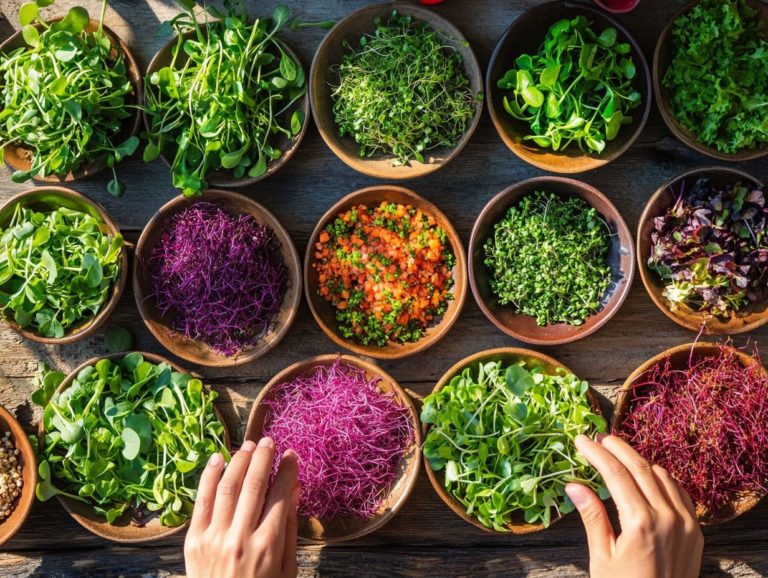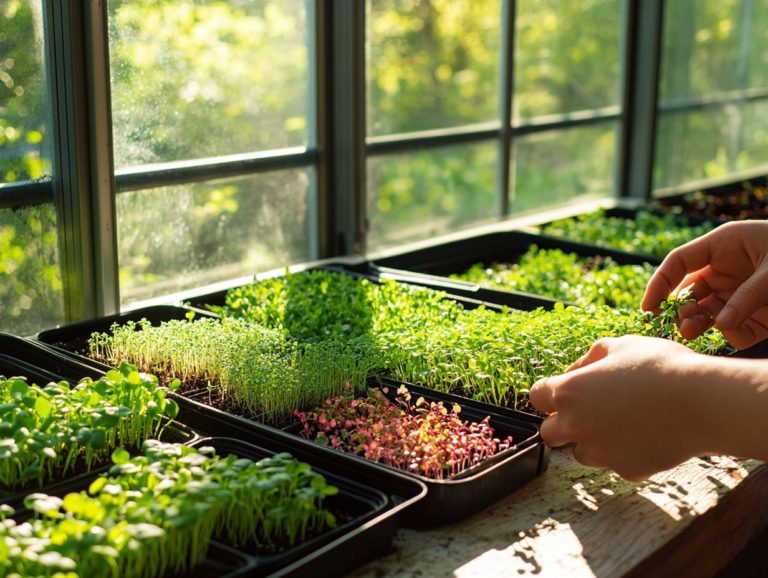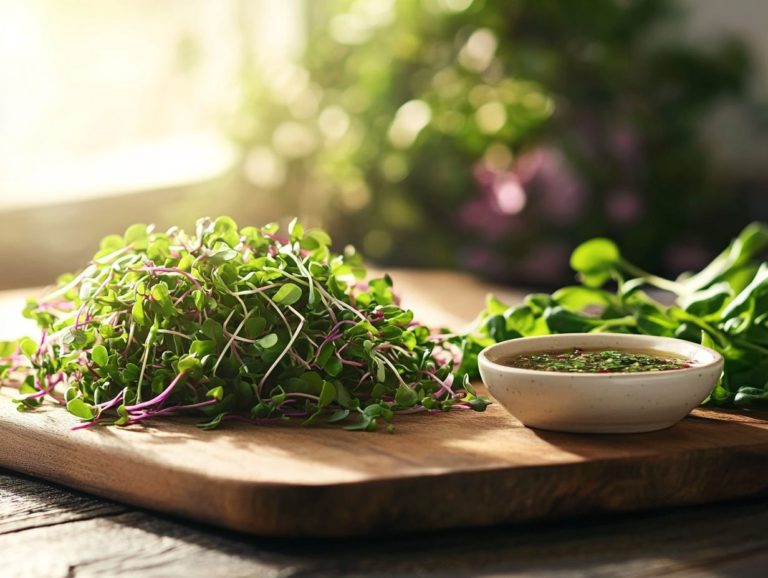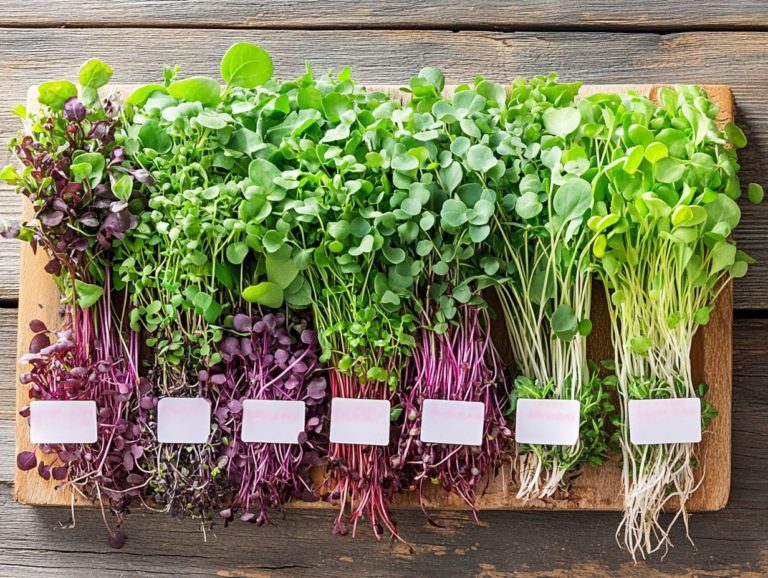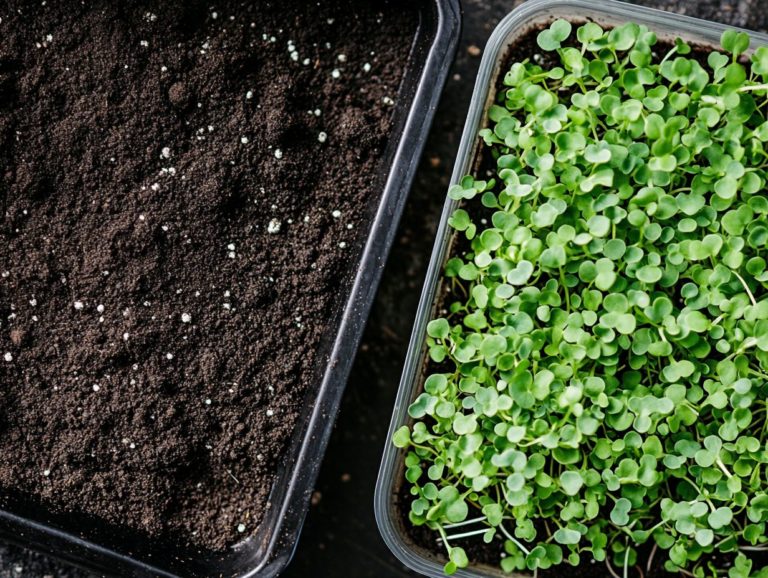How to Prevent Mold in Microgreen Growth?
Mold can be a stealthy foe in your journey of growing microgreens, turning what should be a bountiful harvest into a vexing setback. Humidity and soil drainage can exacerbate mold issues.
To grow healthy microgreens, it s crucial for you to understand the causes and effects of mold growth. This article explores effective prevention techniques, ideal growing environments, and the importance of maintaining sanitation and hygiene practices, including sanitizing seeds.
You ll learn how the quality of your soil and water influences mold development, affecting the root hairs of microgreen seeds. Get ready to discover the secrets to growing vibrant, mold-free microgreens!
Contents
Key Takeaways:
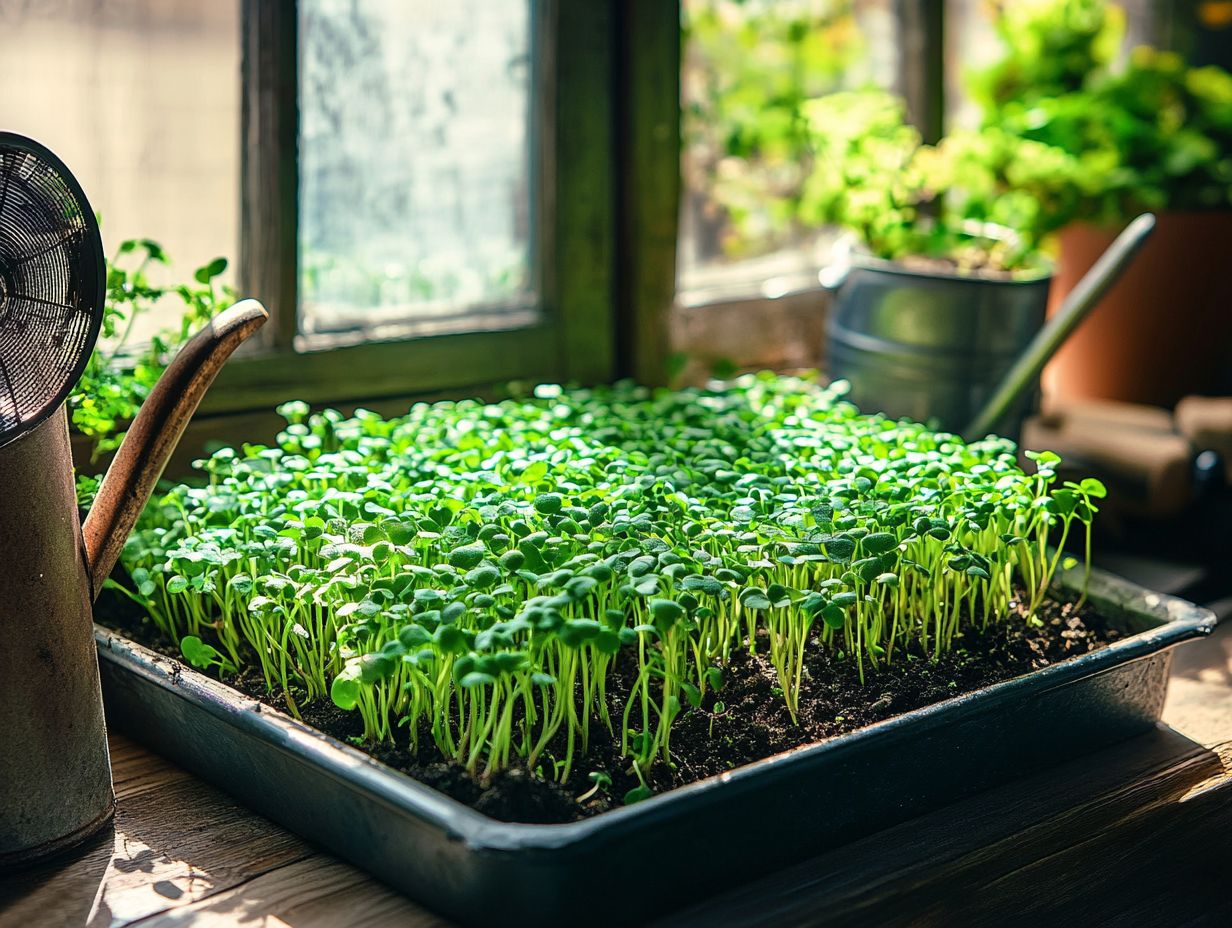
- Regularly clean and disinfect tools and equipment, like trays, to help prevent mold growth in microgreens.
- Choose the right environment with good air circulation and humidity control to prevent mold.
- Use high-quality soil and filtered water, along with effective bottom watering methods, to significantly reduce mold growth.
What You Need to Know About Mold in Microgreens
Understanding mold growth in microgreens is essential for aspiring growers eager to cultivate thriving crops. Mold, often appearing as a troublesome white fuzzy substance, is a type of fungus that can impede the growth of microgreens like borage, broccoli, kale, and cabbage.
Factors such as excess humidity, poor soil moisture, and insufficient air circulation can foster this unwelcome fungus. By pinpointing these critical elements, including seed density, you can take proactive steps to mitigate and prevent mold growth. For more detailed strategies, check out how to prevent spoilage in microgreens, ensuring your microgreen seeds flourish in a pristine environment.
Causes and Consequences of Mold Growth
The primary causes of mold growth in microgreens are linked to environmental factors such as high humidity, inadequate soil drainage, and poor air circulation.
When these conditions persist, the delicate balance essential for healthy growth is disrupted, creating a prime environment for mold spores to thrive. High humidity, often from insufficient air circulation, poor soil drainage, or excess watering, can lead to moisture build-up, while poorly designed drainage systems struggle to divert excess water away from the roots.
This harmful combination can hinder proper seed germination and significantly damage young crops. The effects of mold growth extend beyond visual concerns; they pose serious health risks, including potential contamination of microgreen seeds, and can ultimately lead to crop loss.
Microgreen seeds affected by mold may experience reduced germination rates, and any contamination could compromise the quality of the produce, raising serious concerns about both health and market viability.
Preventing Mold Growth in Microgreens

Preventing mold growth in microgreens is crucial for cultivating a healthy and thriving crop. This can be achieved through effective mold prevention techniques, including hydrogen peroxide and grapefruit seed extract applications. By ensuring optimal air circulation and utilizing bottom watering methods, you can greatly reduce the chance of mold infestations.
Carefully managing seed density will give your microgreens such as radishes, peppers, Swiss chard, and cilantro ample space to grow, minimizing excess humidity buildup and promoting healthy root hair development. This thoughtful approach paves the way for a successful and bountiful harvest.
Start your journey to fresh, mold-free microgreens today!
Effective Prevention Techniques
To prevent mold in your microgreens, use natural solutions. Options include hydrogen peroxide, vinegar, and grapefruit seed extract.
Hydrogen peroxide, when mixed with water, can help prevent mold. It acts as a safe spray for your seedlings.
Vinegar serves as a natural way to fight mold when mixed with water. It promotes your plants’ overall well-being and protects vital root hairs.
Grapefruit seed extract is another strong ally. It can be added to your watering routine to boost growth and resist mold.
Each method offers distinct benefits, ensuring your microgreens flourish without the looming threat of mold.
Choosing the Right Environment for Microgreens
Selecting the perfect environment for microgreens is essential for healthy growth. Managing soil moisture and air circulation is crucial.
Consider factors such as humidity levels, soil drainage, and air circulation. These elements help establish an optimal setting for different microgreens, like broccoli, kale, borage, and cilantro.
By fine-tuning these conditions, you can reduce the chances of mold and foster vigorous development of your microgreens, contributing to a successful harvest. If you encounter issues, refer to this guide on how to troubleshoot microgreen growth problems for effective solutions.
Factors that Contribute to Mold Growth
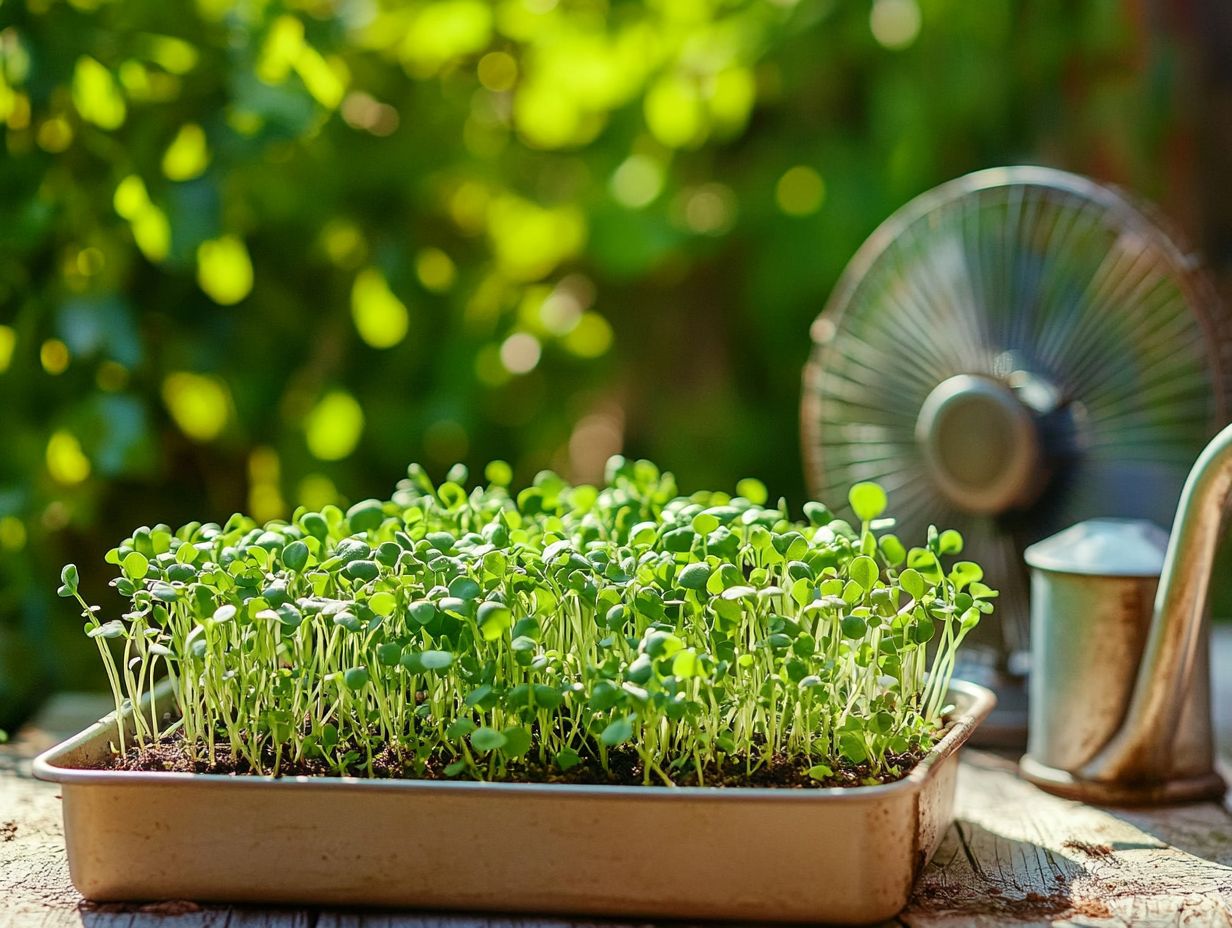
Several factors play a significant role in mold growth in microgreens. Humidity, soil moisture, and the health of root hairs are key elements.
Understanding the interplay of these elements, including proper ventilation, is essential for cultivating vibrant, healthy microgreens.
Achieving the right humidity level can be managed through good ventilation and air circulation. This reduces the likelihood of mold.
Using fans or creating natural airflow can significantly diminish stagnant conditions where mold thrives. This contributes to healthier microgreens.
Keep a close watch on soil moisture. Overwatering creates a damp environment that invites fungal growth and compromises the health of your seeds.
Start monitoring your air and soil conditions today to keep mold at bay!
Proper Sanitation and Hygiene Practices
Maintaining proper sanitation and hygiene practices is crucial for preventing mold in microgreens. Ensure all tools, seeds, and growing environments are free from contaminants.
Sanitize seeds before planting and regularly clean trays and equipment. This greatly reduces the risk of mold growth in your cultivation.
By committing to strict hygiene protocols, you cultivate healthier microgreens and enhance your overall yield. This is essential in successful microgreen farming.
Cleaning and Disinfecting Tools and Equipment
Cleaning your tools isn t just important; it s vital for thriving microgreens! Let’s dive in.
Cleaning and disinfecting your tools and equipment is essential in the microgreen growing process, as it significantly reduces the risk of mold contamination from leftover plant debris.
To create an optimal growing environment, you should adopt a systematic approach to sanitation. Begin by thoroughly removing any plant debris or residues from your microgreen cultivation before introducing disinfectants.
- First, rinse all your tools with warm water to eliminate dirt and organic matter.
- Next, prepare a solution using either a commercial disinfectant or a mix of bleach and water, making sure it s diluted correctly.
- After soaking the equipment for the recommended duration, rinse it once more and allow it to air dry completely.
Regularly inspecting and cleaning your tools won t just prolong their lifespan; it will also keep your growing area free from unwanted pathogens, ultimately enhancing your overall productivity in growing healthy microgreens.
Using Quality Soil and Water for Growth
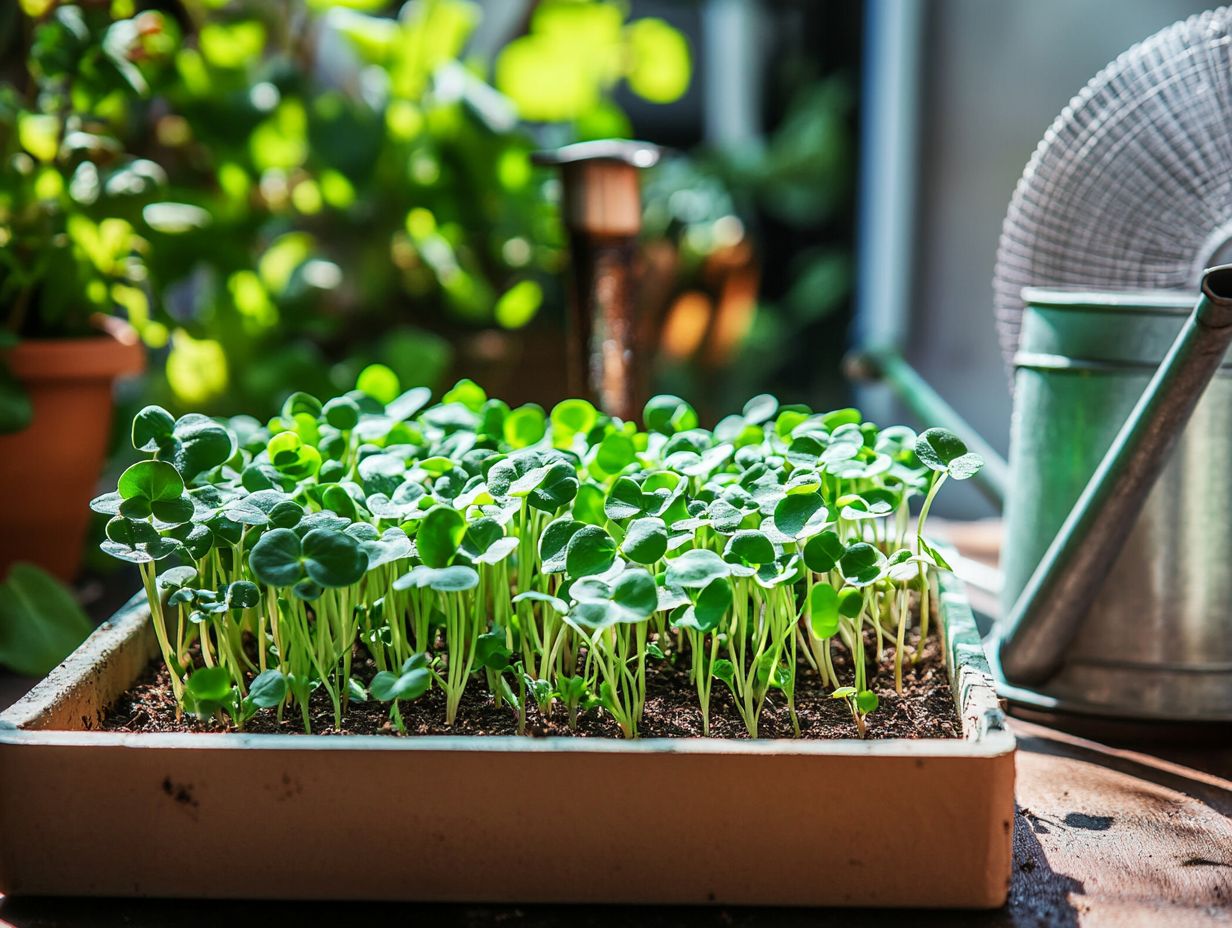
Utilizing quality soil and pristine water is crucial for cultivating microgreens, as it directly impacts their health, including the vitality of root hairs and susceptibility to mold. The ideal soil composition and its ability to retain moisture can profoundly affect the growth of your microgreen seeds.
Meanwhile, using clean, uncontaminated water guarantees that your plants receive essential nutrients without the risk of harmful pathogens, contributing to effective mold prevention. Together, these elements establish a robust foundation for thriving microgreens.
Impact of Soil and Water Quality on Mold Growth
The influence of soil and water quality on mold growth in microgreens is crucial. Poor-quality soil and contaminated water can easily create a haven for mold, impacting root hairs and seed germination.
Unfavorable conditions hinder the growth of these delicate plants and jeopardize your overall yield, potentially leading to substantial waste in your home microgreens. Understanding how these factors interact is essential for anyone looking to cultivate vibrant and healthy microgreens.
Regularly monitoring and assessing soil texture, pH levels (which measure how acidic or basic a substance is), and water purity will provide you with vital insights into your cultivation environment and help in preventing mold.
For the best conditions, focus on high-quality, sterilized soil and filtered water, as these components are key to reducing the risk of mold contamination. Incorporating organic matter, like compost, can significantly enhance soil health by improving aeration and drainage, effectively limiting moisture retention, a major contributor to mold growth. Additionally, knowing how to properly store microgreen supplies can further ensure healthy growth.
Periodically testing your water for contaminants and adjusting nutrient levels will further protect against adverse effects, ensuring your microgreen seeds thrive without the threat of mold.
Practicing good hygiene such as sanitizing your equipment and workspace will help minimize the chances of mold spores taking hold. By employing these practical strategies, you will not only foster vigorous microgreen growth but also pave the way for a successful and bountiful harvest. If you encounter any setbacks, refer to our guide on troubleshooting common microgreen growth issues for helpful solutions.
Frequently Asked Questions
Consider adding common questions related to mold prevention to enhance reader engagement.
How can I prevent mold from growing in my microgreens?
1. Use good quality seeds. Make sure the seeds for your microgreens are top-notch. Low-quality seeds may carry mold spores that encourage growth.
2. Ensure proper ventilation. Good air circulation is important to stop mold. Provide enough ventilation in the growing area to keep moisture in check.
3. Use sterile growing medium. A sterile medium like soilless mix or coco coir helps prevent mold. Avoid regular garden soil, as it often contains unwanted spores.
4. Water carefully. Overwatering can lead to mold growth. Only water your microgreens when the top layer of soil feels dry!
5. Keep the growing area clean. Regularly clean your trays and containers. This simple habit helps stop bacteria and mold spores from accumulating.
6. Harvest at the right time. Don t wait too long to harvest your microgreens! Picking them at the right moment prevents excess moisture and mold growth.

